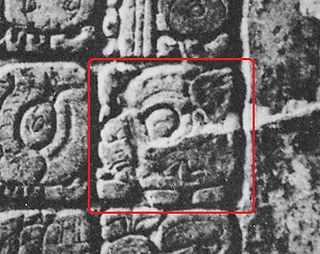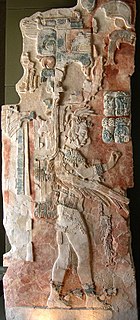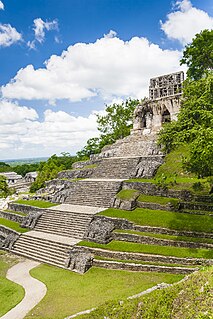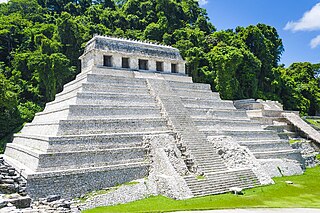
Kʼinich Janaab Pakal I (Mayan pronunciation: [kʼihniʧ xanaːɓ pakal], also known as Pacal, Pacal the Great, 8 Ahau and Sun Shield, was ajaw of the Maya city-state of Palenque in the Late Classic period of pre-Columbian Mesoamerican chronology. He acceded to the throne in July 615 and ruled until his death. During a reign of 68 years, the longest known regnal period in the history of the Americas, the 30th longest worldwide and longest until Frederick III in the 15th century, Pakal was responsible for the construction or extension of some of Palenque's most notable surviving inscriptions and monumental architecture.

Sak Kʼukʼ also known as Muwaan Mat, Lady Sak Kʼukʼ and Lady Beastie, was queen of the Maya city-state of Palenque. She acceded to the throne in October, 612 and ruled until 615.

Ajen Yohl Mat also known as Aj Neʼ Ohl Mat, Ac Kan and Ahl Lawal Mat, was an ajaw of the Maya city-state of Palenque. He acceded to the throne on January 1, 605 and ruled until his death. He was probably son of Yohl Ikʼnal or Sak Kʼukʼ and brother of Janahb Pakal or Kʼinich Janaab Pakal I. During his reign, his kingdom was invaded on April 4, 611 by Scroll Serpent, ruler of the Kaan kingdom (Calakmul).

Yohl Ikʼnal, also known as Lady Kan Ik and Lady Kʼanal Ikʼnal, was queen of the Maya city-state of Palenque. She acceded to the throne on December 23, 583, and ruled until her death.

Kʼukʼ Bahlam I, also known as Kuk and Bahlum Kʼukʼ,, was a founder and ajaw of the ruling dynasty at the Maya city of Palenque. He founded the dynasty on March 10, 431.

Ahkal Moʼ Nahb II also known as Chaacal II and Akul Anab II, was an ajaw of the Maya city-state of Palenque. He took the throne on May 2, 565, he was grandson of Ahkal Moʼ Nahb I and probably brother of Kan Bahlam I. He enthroned eighty-five days after death of Kʼan Joy Chitam I.

Kan Bahlam I, also known as Chan Bahlum I, was an ajaw of the Maya city-state of Palenque. He acceded to the throne on April 6, 572 at age 47 and ruled until his death. Kan Bahlam was most likely the younger brother of his predecessor, Ahkal Mo' Nahb II and probably son of K'an Joy Chitam I. He was the first ruler of Palenque to use the title K'inich, albeit inconsistently. The title is usually translated as "radiant" but literally means "sun-faced".

Kʼinich Ahkal Moʼ Nahb III also known as Chaacal III and Akul Anab III,, was an ajaw of the Maya city of Palenque. He took the throne on 30 December 721, reigning until c.736.

Kʼinich Kʼan Joy Chitam II, also known as Kan Xul II and Kʼan Hokʼ Chitam II, October 31, 644 – c.721, was an ajaw of the Maya city of Palenque. He took the throne on May 28, 702 (9.13.10.6.8), reigning until c.721. He succeeded his elder brother Kʼinich Kan Bahlam II. Their father was Kʼinich Janaab Pakal I, who had ruled for 68 years, and their mother was Lady Tzʼakbu Ajaw. His possible brother could be Tiwol Chan Mat. Kʼinich Kʼan Joy Chitam apparently reigned for about nine years. He was captured by the Toniná in 711 and was possibly executed by their leader, Kʼinich Baaknal Chaak or was later restored to his kingship. He was succeeded in late 721 by Kʼinich Ahkal Moʼ Nahb III.

"Casper", also known as 11 Rabbit,, was an ajaw of the Maya city of Palenque from August 9, 435 to 487. He was the immediate successor of K'uk' Bahlam I, who founded the ruling dynasty.

During the 7th and 8th centuries in Mesoamerica, there was an evident shift in the roles women played in ancient Maya society as compared with the previous two centuries. It was during this time that there was a great deal of political complexity seen both in Maya royal houses as well as in the Maya area. Warfare was a significant factor in political competition and marriage was one of the ways that alliances were made between the different polities. This was accompanied by a shift in women's roles from wife and mother to playing integral parts in courtly life, such as participating in rituals involving the supernatural world and at times ruling individual polities.

Itzam Kʼan Ahk II, also known as Ruler 4, was an ajaw of Piedras Negras, an ancient Maya settlement in Guatemala. He ruled during the Late Classic Period, from 729–757 AD. Itzam Kʼan Ahk II ascended to the throne following the death of Kʼinich Yoʼnal Ahk II. Itzam Kʼan Ahk II may have fathered the following three kings of Piedras Negras: Yoʼnal Ahk III, Haʼ Kʼin Xook, and Kʼinich Yat Ahk II. Following Itzam Kʼan Ahk II's demise, he was succeeded by Yoʼnal Ahk III in 757 AD. Itzam Kʼan Ahk II left behind several monuments, including stelae at Piedras Negras and a large mortuary temple now known as Pyramid O-13. In addition, the details of his life and his Kʼatun-jubilee were commemorated on Panel 3, raised by Kʼinich Yat Ahk II several years following Itzam Kʼan Ahk II's death.
Kʼan Moʼ Hix,, was a nobleman of the Maya city-state of Palenque. He was husband of Sak Kʼukʼ, queen of Palenque, and father of Kʼinich Janaab Pakal I, who was one of the greatest rulers of Palenque and was responsible for the construction or extension of some of Palenque's most notable surviving inscriptions and monumental architecture. He could be a possible father of Ajen Yohl Mat.

Pomona is a Maya archaeological site in the Mexican state of Tabasco, municipality of Tenosique, about 30 miles east of Palenque. Its flowering was in the Late Classic period.

Kʼinich Kʼukʼ Bahlam II, also known as Bahlum Kʼukʼ II and Mahkʼina Kuk,, was an ajaw of the Maya city of Palenque. He acceded to the throne on March 4, 764 and ruled until c. 783. He was a son of Kʼinich Ahkal Moʼ Nahb III and Lady Men Nik. Knowledge of him is limited to a few broken monuments: the Tablet of the 96 glyphs, the Creation Tablet, the House B Mural? and Bodega no. 218.

Kʼinich Kan Bahlam III,, was an ajaw of the Maya city of Palenque. He ruled c.751. Ruler is not mentioned in any monument at Palenque but only one text at Pomona, that suggest his reign was short or troubled.

Kʼinich Janaab Pakal II, also known as Upakal Kʼinich,, was an ajaw of the Maya city of Palenque. He ruled c.742 and he was probably brother of Kʼinich Ahkal Moʼ Nahb III. There are only few details about his reign like Bodega no. 1144 and portraits on a stucco-covered pier from Temple 19, only date from his reign is from 742, when he installed lord into important office.






















